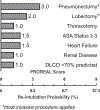Reintubation After Lung Cancer Resection: Development and External Validation of a Predictive Score
- PMID: 35690135
- PMCID: PMC11651361
- DOI: 10.1016/j.athoracsur.2022.05.035
Reintubation After Lung Cancer Resection: Development and External Validation of a Predictive Score
Abstract
Background: Reintubation after lung cancer resection is an important quality metric because of increased disability, mortality and cost. However, no validated predictive instrument is in use to reduce reintubation after lung resection. This study aimed to create and validate the PRediction Of REintubation After Lung cancer resection (PROREAL) score.
Methods: The study analyzed lung resection cases from 2 university hospitals. The primary end point was reintubation within 7 days after surgery. Predictors were selected through backward stepwise logistic regression and bootstrap resampling. The investigators used reclassification and receiver-operating characteristic (ROC) curve analyses to assess score performance and compare it with an established score for all surgical patients (Score for Prediction of Postoperative Respiratory Complications [SPORC]).
Results: The study included 2672 patients who underwent resection for lung cancer (1754, development cohort; 918, validation cohort) between 2008 and 2020, of whom 71 (2.7%) were reintubated within 7 days after surgery. Identified score variables were surgical extent and approach, American Society of Anesthesiologists physical status, heart failure, renal disease, and diffusing capacity of the lung for carbon monoxide. The score achieved excellent discrimination in the development cohort (ROC AUC, 0.90; 95% CI, 0.87-0.94) and good discrimination in the validation cohort (ROC AUC, 0.74, 95% CI; 0.66-0.82), thus outperforming the SPORC in both cohorts (P < .001 and P = .018, respectively; validation cohort net reclassification improvement, 0.39; 95% CI, 0.18-0.60; P = .001). The score cutoff of ≥5 yielded a sensitivity of 88% (95% CI, 72-95) and a specificity of 81% (95% CI,79-83) in the development cohort.
Conclusions: A simple score (PROREAL) specific to lung cancer predicts postoperative reintubation more accurately than the nonspecific SPORC score. Operative candidates at risk may be identified for preventive intervention or alternative oncologic therapy.
Copyright © 2024 The Society of Thoracic Surgeons. Published by Elsevier Inc. All rights reserved.
Conflict of interest statement
DISCLOSURES
The authors have no conflicts of interest to disclose.
Figures




Similar articles
-
Development and validation of a score for prediction of postoperative respiratory complications in infants and children (SPORC-C).Br J Anaesth. 2025 Jan;134(1):212-220. doi: 10.1016/j.bja.2024.07.011. Epub 2024 Aug 5. Br J Anaesth. 2025. PMID: 39107163
-
Development and validation of a score for prediction of postoperative respiratory complications.Anesthesiology. 2013 Jun;118(6):1276-85. doi: 10.1097/ALN.0b013e318293065c. Anesthesiology. 2013. PMID: 23571640
-
The development and validation of the Score for the Prediction of Postoperative Respiratory Complications (SPORC-2) to predict the requirement for early postoperative tracheal re-intubation: a hospital registry study.Anaesthesia. 2019 Sep;74(9):1165-1174. doi: 10.1111/anae.14742. Epub 2019 Jun 20. Anaesthesia. 2019. PMID: 31222727 Free PMC article.
-
Perioperative Risk Factors Associated With Postoperative Unplanned Intubation After Lung Resection.J Cardiothorac Vasc Anesth. 2018 Aug;32(4):1739-1746. doi: 10.1053/j.jvca.2018.01.032. Epub 2018 Jan 31. J Cardiothorac Vasc Anesth. 2018. PMID: 29506893
-
Risk prediction model for respiratory complications after lung resection: An observational multicentre study.Eur J Anaesthesiol. 2016 May;33(5):326-33. doi: 10.1097/EJA.0000000000000354. Eur J Anaesthesiol. 2016. PMID: 26535555
Cited by
-
Multiple automated machine-learning prediction models for postoperative reintubation in patients with acute aortic dissection: a multicenter cohort study.Front Med (Lausanne). 2025 Apr 11;12:1531094. doi: 10.3389/fmed.2025.1531094. eCollection 2025. Front Med (Lausanne). 2025. PMID: 40291030 Free PMC article.
-
Development of an automated, general-purpose prediction tool for postoperative respiratory failure using machine learning: A retrospective cohort study.J Clin Anesth. 2023 Nov;90:111194. doi: 10.1016/j.jclinane.2023.111194. Epub 2023 Jul 7. J Clin Anesth. 2023. PMID: 37422982 Free PMC article.
References
-
- Bray F, Ferlay J, Soerjomataram I, Siegel RL, Torre LA, Jemal A. Global cancer statistics 2018: GLOBOCAN estimates of incidence and mortality worldwide for 36 cancers in 185 countries. CA Cancer J Clin. 2018;68:394–424. - PubMed
-
- Nafiu OO, Ramachandran SK, Ackwerh R, Tremper KK, Campbell DA Jr, Stanley JC. Factors associated with and consequences of unplanned post-operative intubation in elderly vascular and general surgery patients. Eur J Anaesthesiol. 2011;28:220–224. - PubMed
-
- Burton BN, Khoche S, A’Court AM, Schmidt UH, Gabriel RA. Perioperative risk factors associated with postoperative unplanned intubation after lung resection. J Cardiothorac Vasc Anesth. 2018;32:1739–1746. - PubMed
-
- Dimick JB, Chen SL, Taheri PA, Henderson WG, Khuri SF, Campbell DA Jr. Hospital costs associated with surgical complications: a report from the private-sector National Surgical Quality Improvement Program. J Am Coll Surg. 2004;199:531–537. - PubMed
Publication types
MeSH terms
Grants and funding
LinkOut - more resources
Full Text Sources
Medical

